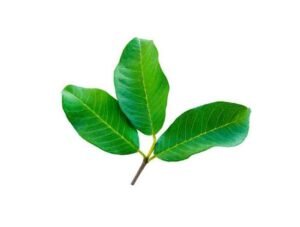The Leaf Class-6 Srijan ICSE Biology Solutions Chapter-1 Veer Bala Rastogi Srijan Publishers Solutions. We Provide Step by Step Solutions of Fill in the blanks, Give functions, Define the following, Differentiate between the following, Match the following, True and False, MCQs and Answer these Questions of Veer Bala Rastogi Srijan Biology Publishers. Visit official Website CISCE for detail information about ICSE Board Class-6.
The Leaf Class-6 Srijan ICSE Biology Solutions Chapter-1
| Board | ICSE |
| Class | 6th |
| Subject | Biology |
| Book Name | Srijan |
| Chapter-1 | The Leaf |
| Unit-1 | The Leaf |
| Topic | Solution of exercise questions |
| Session | 2023-24 |
The Leaf ICSE Class-6th Srijan
Biology Solutions Chapter-1
A. Fill in the blanks with suitable words:
1. Neem leaves are ….simple…. (simple/compound)
2. Banana leaves are ….sessile….. (stalked/sessile)
3. The green expanded and flattened part of leaf is called ….lamina…. (lamina/leaflet)
4. In ….flytrap…. the lamina is divided into two parts and have toothed margins. (sundew/Venus /flytrap)
B. Give functions of the following :
Question: 1. Veins in the lamina
Answer: Leaf veins are present throughout the leaf lamina which supports the structure of the leaf. Leaf veins contain the conducting tissue xylem which carries water and minerals to the leaf. Phloem present in the veins transports the food (glucose) produced in the leaf during photosynthesis.
Question: 2. Petiole of leaf
Answer: Petiole helps to twist the leaf to face the sun. It allows the transport of the energy synthesized in the leaf to the rest of the plant. It also enables the transport of nutrients and water to the leaf.
Question: 3. Pitcher in pitcher plant
Answer: It attracts insects using its smell. Once the insect sits on the pitcher of the plant, it closes its lid, trapping the insect. Its leaves are modified to form the pitcher.
Question: 4. Spines in cactus.
Answer: In xerophytic plants like cacti and Opuntia, the leaves are modified into spines. These spines check the loss of water from the plant body and thus help the plant to conserve water. The spines also deter the herbivores feeding on the cactus. Tendrils are the leaf modifications that help the plant in climbing.
C. Name the process:
Question: 1. Loss of water from the surface of lamina.
Answer: Transpiration
Question: 2. Formation of new plants from the buds present on the margin of leaf.
Answer: Vegetative propagation
Question: 3. Synthesis of food from carbon dioxide and water in presence of sunlight.
Answer: Photosynthesis
D. Define the following:
Question: 1. Photosynthesis
Answer: Photosynthesis is the process by which plants use sunlight, water, and carbon dioxide to create oxygen and energy in the form of sugar.
Question: 2. Transpiration
Answer: Transpiration is the process in which water is lost as water vapor from the aerial parts of the plants through stomata. Transpiration is essentially evaporation of water from the leaves of the plant.
Question: 3. Vegetative propagation
Answer: Vegetative propagation is an asexual method of plant reproduction that occurs in its leaves, roots and stem. This can occur through fragmentation and regeneration of specific vegetative parts of plants.
E. Differentiate between the following:
Question: 1. Monocot and dicot leaf
Answer:
| Monocot Leaf | Dicot Leaf |
| 1. Plants having only one cotyledon within the seed are called monocotyledons or monocot plant | Plants having two cotyledons within a seed are called dicotyledons or dicot plants. |
| 2. They have a fibrous root system | They have a tap root system |
| 3. Leaves in monocots have parallel venation | Leaves in dicots have reticulate or net venation |
| 4. Flower parts are present in multiples of three. | The flower parts are present in multiples of four or five. |
| 5. A few examples of monocotyledons are garlic, onions, wheat, corn, and grass, etc. | A few examples of dicots are beans, cauliflower, apples and pear, etc. |
Question: 2. Simple and compound leaf
Answer:
| Simple Leaf | Compound Leaf |
| 1. The notches present at the leaf margin do not reach the midrib, keeping the lamina intact. | The notches extend towards the midrib resulting in small plantlets due to the divided lamina. |
| 2. Axillary buds develop from the base of the simple leaf. | Leaflets do not possess any axil and hence axillary buds are absent. |
| 3. The midrib or the central large midvein is a part of the lamina. | The leaflets originate from the midvein in a compound leaf. |
| 4. Examples: mango, guava and banyan. | Examples: neem, shame plant and rose. |
Question: 3. Reticulate and parallel venation
Answer:
| Reticulate venation | Parallel venation |
| 1. Veins are arranged in a network or web-like structure. | Veins run parallel to each other. |
| 2. This pattern is typically seen in dicotyledonous plants. | This pattern is seen in monocotyledonous plants. |
| 3. Example: Rose, Mango, Hibiscus, etc. | Example: Wheat, Maize, Banana, etc. |
F. Answer these questions:
Question: 1. State the function of tendrils with an example.
Answer: State the function of tendrils with an example:
- In some plants having weak stems, the leaves are modified to form thin coiled structures called leaf tendrils.
- Plants with weak stems need a support to grow in a vertically upward direction.
- The leaf tendrils coil around the support and help the plant grow.
- Examples: grapevine and pea plants have leaf tendrils.
Question: 2. Name the parts of a typical leaf.
Answer: There are three main parts of a leaf – Leaf base, leaf lamina, and petiole.
Question: 3. Give three main functions of leaves.
Answer: Three main functions of leaves:
- Leaf prepares food for plants by the process of photosynthesis.
- Leaf has abundant stomata for gaseous exchange and performs the function of respiration.
- The leaf is the main site of water loss through the process of transpiration.
Question: 4. Give two examples of insectivorous plants.
Answer: Two examples of Insectivorous plants are Bladderwort and Venus flytrap.
Question: 5. In what form is food synthesised in leaves and in what form is it stored?
Answer: Plants synthesise their own food by the process of photosynthesis. Food is synthesised by the plants in the form of glucose, stored in the form of starch and is transported in the form of sucrose.
G. Match the columns:
| Column A | Column B |
| 1. Reticulate venation | (a) Insectivorous plant |
| 2. Leaf tendril | (b) Parallel venation |
| 3. Pitcher plant | (c) Movement of water |
| 4. Maize leaf | (d) Photosynthesis |
| 5. Chlorophyll | (e) Dicot leaf |
| 6. Veins and veinlets | (f) Sweet pea |
Answer:
| Column A | Column B |
| 1. Reticulate venation | (a) Dicot leaf |
| 2. Leaf tendril | (b) Sweet pea |
| 3. Pitcher plant | (c) Insectivorous plant |
| 4. Maize leaf | (d) Parallel venation |
| 5. Chlorophyll | (e) Photosynthesis |
| 6. Veins and veinlets | (f) Movement of water |
H. State whether the following statements are true or false. If false, rewrite the correct form of statements:
| Statements | True/False |
| 1. Midrib in lamina is the extension of petiole. | T |
| 2. Flashy leaves are found in Begonia. | T |
| 3. Scale leaves are for saving water | T |
| 4. Rose leaves are simple leaves. | F |
| 5. Some leaves in pea form spines. | F |
I. Multiple Choice Questions:
1. The leaf is attached to the stem at
(a) Petiole
(b) Node
(c) Spine
(d) Internode
Answer: option (b) Node is correct
2. The leaves of monocot plants are
(a) Stalked and have parallel venation
(b) Sessile and have parallel venation
(c) Sessile and have reticulate venation
(d) Stalked and have reticulate venation
Answer: option (b) Sessile and have parallel venation is correct
3. Main functions of leaf is
(a) Transpiration and photosynthesis
(b) Photosynthesis and respiration
(c) Respiration and transpiration
(d) Photosynthesis, respiration and transpiration
Answer: option (d) Photosynthesis, respiration and transpiration is correct
4. The arrangement of veins in the lamina is called
(a) Venation
(b) Transpiration
(c) Pollination
(d) Fixation
Answer: option (a) Venation is correct
5. Leaves are modified into tendrils in
(a) Gram
(b) Bitter guard
(c) Pea
(d) Wheat
Answer: option (c) Pea is correct
6. Plants use carbon dioxide in
(a) Photosynthesis and respiration
(b) Photosynthesis only
(c) Respiration only
(d) None of these processes
Answer: option (b) Photosynthesis only is correct
J. Diagram-based questions:
Give below are pictures of two leaves:


Question: (a) What does each picture represent?
Answer: The first picture represent a compound leaf and the second picture represent a simple leaf.
Question: (b) What difference do you notice between the two.
Answer: In a compound leaf, the lamina is incised up to midrib and form various leaflets.
Question: (c) Give one example of each type of leaf.
Answer: Simple leaf is singular and never divided into smaller leaflets units.
— : End of The Leaf Class-6 Srijan ICSE Biology Solutions Chapter-1:–
Return to- ICSE Class -6 Srijan Biology Solutions
Thanks.
Please share with your friends if you find it useful.


